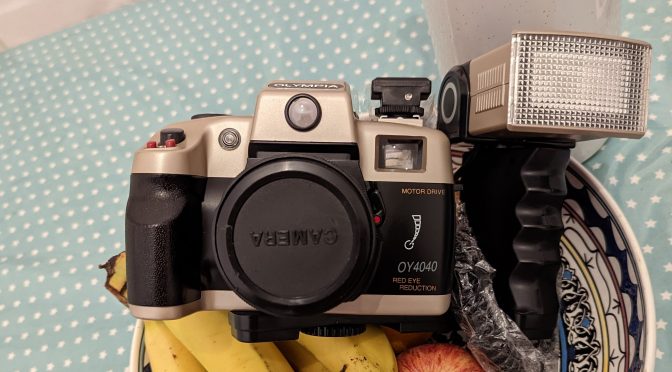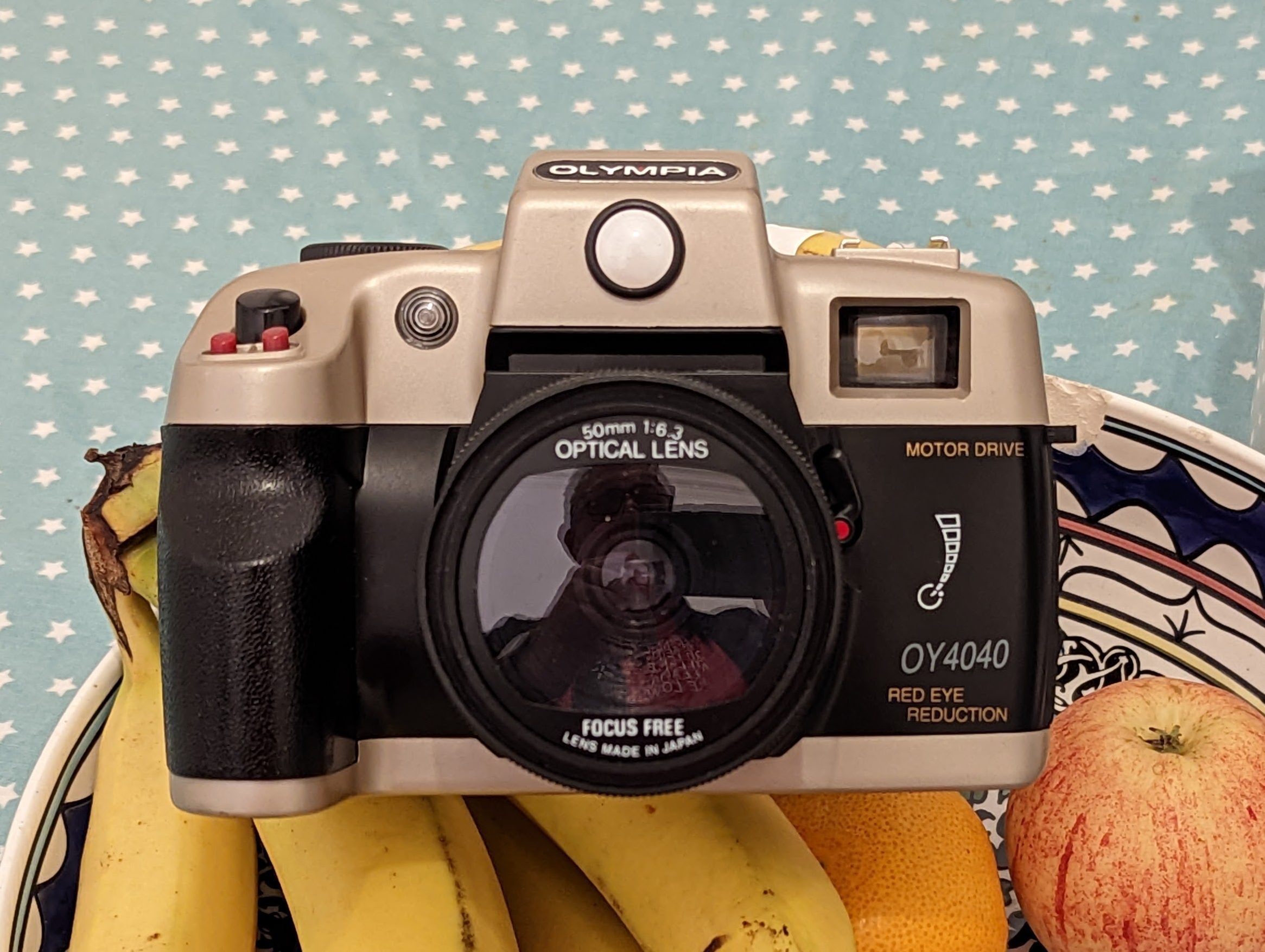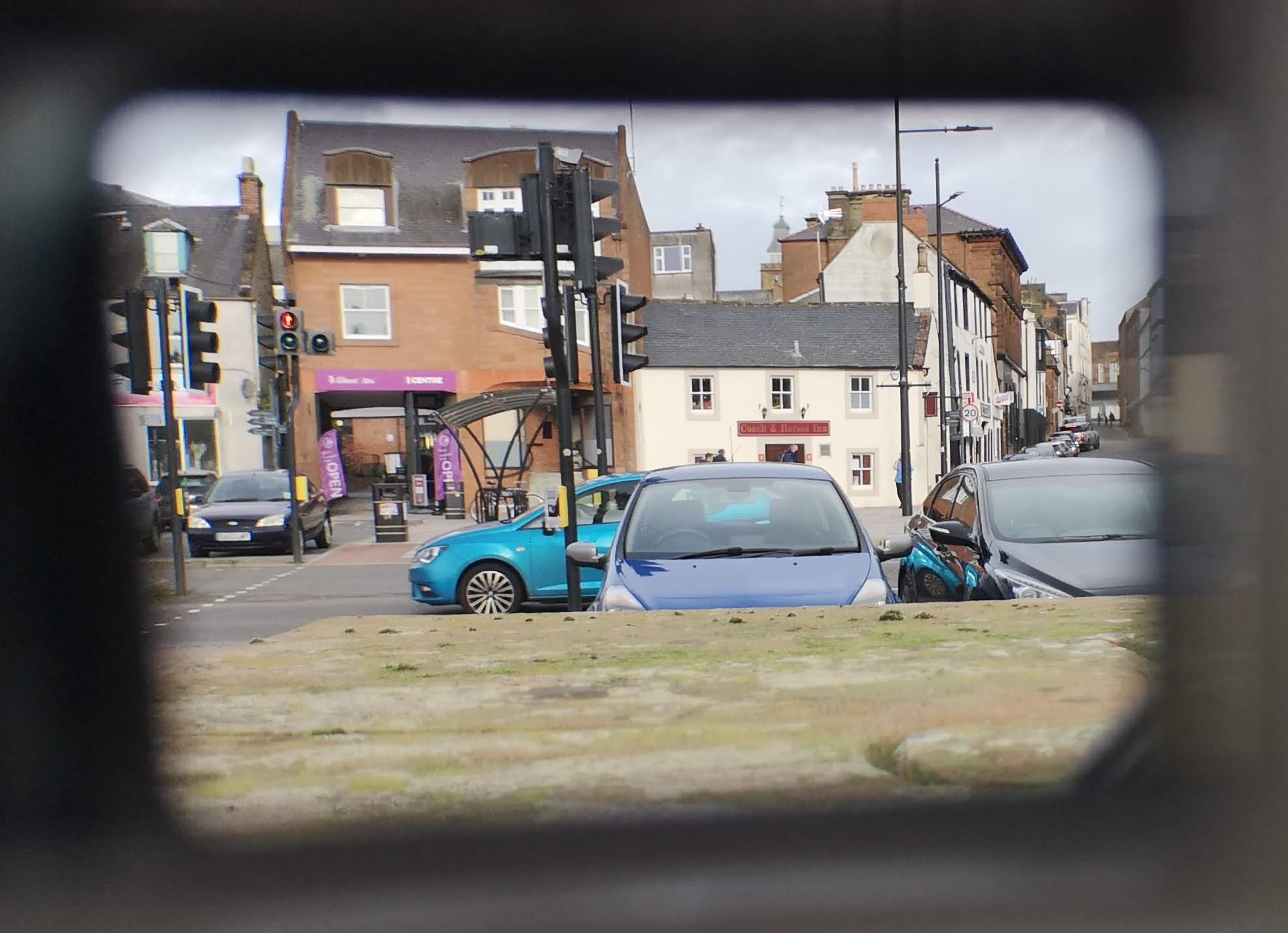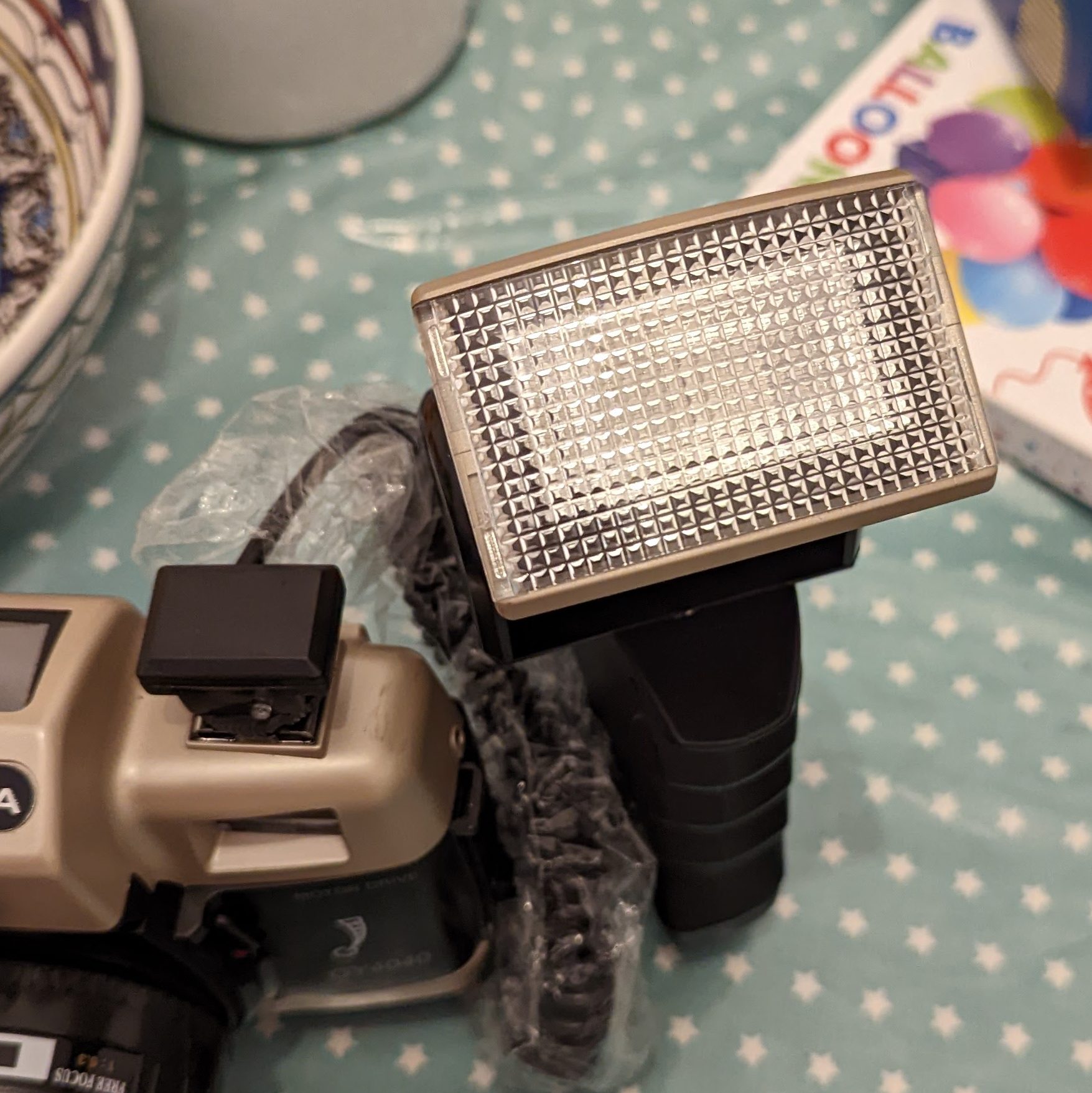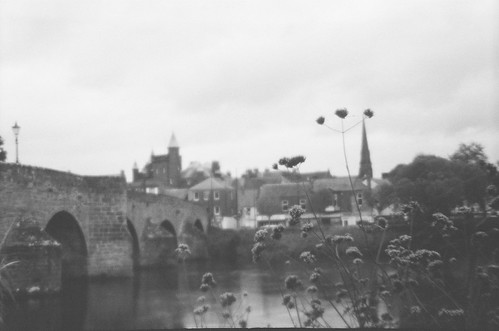The Olympia camera brand has a legendary status. It is as the archetype Scamera. Perfidiously sold as a high end model to unsuspecting smucks, these lumps of plastic are the most famous of the legion of Color Optical Lens Scameras. The OY4040 is one of their midrange models. But just how bad is it ?
In my defence I knew what I was getting. I’ve trod this ground before and have at points owned a Mintax, Nikai, Roniflex as well as some less scammy color optical lens cameras.
It was also a charity auction – and given the OY4040 came spilt new and with a Fujifilm Instax wide 100 and a Olympus iS-1000 for a tenner I can’t grumble and it’s better off in the charity’s pocket than mines.
It turns out that this may be the one of the most advanced Olympia scamera ever made. That both equally terrible but intriguing
A Bit of Background –
Meet the Color Optical Lens crew
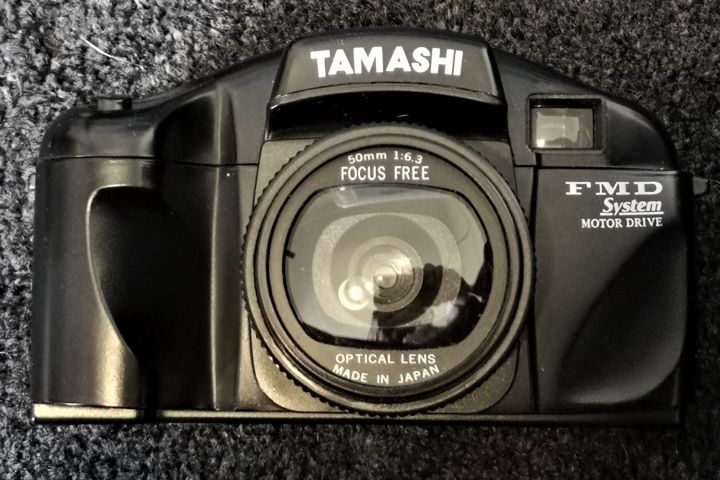
Color Optical Lens cameras as they are known (aka the 50mm plastic cameras of a 1000 names) arguable fit into the same niche as the Diana cameras did before. The main difference is they shoot 35mm film which by 1980’s (120 had become high end or niche).

The cameras were sold as either promos, cheap cameras or scam cameras designed to fool the unwary. They are infamous for this but also have a niche appeal to Lo-Fi shooters. There are legions of these and the true number of models sold is not know but runs well into to the hundreds They all share certain characteristics
- They are styled to resemble SLR (Or occasionally rangefinders) of the day.
- The lens is a fixed focus simple 50mm meniscus lens. Most have 3 to 4 stops between often between f/6.3 and f/16 and all have a single fixed shutter speed. The film plane is always curved to improve focus from the simple single (or occasionally 2) element lens.
- Cheap plastic build quality with plastic optics (bar a few rare glass lensed ones)
- Many but not models have slag metal to add the illusion of the Heft of Quality.

Later models including this one have crude rudimentary motor drive, because by the end of the 80’s and 90’s most real SLRs had them. Some models have addition features (this one has a few as we’ll see) and they were frequently bundled with extras often very cheap flash units.

They are frankly pretty crap but in a good lo-fi way and fill a niche for the Lo-fi crowd.
And the source ?

This work is licensed under a Creative Commons Attribution-NonCommercial-NoDerivs 2.0 Generic License.
The blame for these is largely placed on New Taiwan Photographic Corp which began in 1982. They began production these and other cheap cameras at their plant in Shenzhen, mainland China. The company lasted into the digital age producing cheap digital cameras too.
It is possible other companies made clones but that’s lost in the dust of time.
The Olympia cameras
Our Olympia is clearly in the bad scamera camp. But it was just one of host of Olympia models
The vast bulk are Color Optical Lens cameras
The earliest model I’ve seen is the DL1000. It has a more dated1980’s design where from the DL1010 onwards the models resemble more curved 1990’s AF SLR. The shape would alter subtly
From the D1000 you got the core features of 2 finders and motor drive. That’s seen on most models. Later models like our OY4040 add power focus either by buttons as here or later by a command wheel.
Differences otherwise were cosmetic or down to features like red eye lamps, timers, remotes and later LCD for shutter count.
There is a later models with interchangeable lenses and a pop up flash but you loose the Waist level finder. Then there the weirdness of the V6000….
I’m sure there are non motor winder versions as with other scameras but I’ve yet to see those.

This work isused and is licensed under a Creative Commons Attribution 2.0 Generic License.
These are the ones I know of but I suspect there are more variants.
Olympia models (likely incomplete)
- Big Royal View – like DL1010 but some models more like OY4040 but has “command dial” to do the power zoom and uses a remote control. May just be the 4000 version.
- Big Royal View Deluxe – Similar to DL1010
- Big Royal View 4000 – See command dial Big Royal View
- DL1000- Older styled simple camera with manual only aperture
- DL1010 – More common revised version of DL1000
- DL2000 – pretty much same as DL1010
- DL2000A – pretty much same as DL2000 no idea what difference is. Later models sold scammily with the word digital on the winder knob.
- DL2000GM – DL2000A but with a gold effect to top half
- DL3000R- like a DL1010/2000. R stands for remote control apparently.
- DL9000 – like a DL3000R
- EL1124 – similar to the DL1010
- EF-135 – has interchangeable lenses & pop up flash
- FMD – only single viewfinder – looks like a 2-tone version of Tamashi
- GM8426 – pretty much same as DL1010
- KC2000 – either DL3000R or NK5050 variant – only one image exists
- Lifetime Memories 4000 – Same as Big Royal Deluxe
- NK2121- Pretty much a DL1010
- NK3030 – pretty much same as DL1010
- NK4040 – similar to the OY5050
- NK5050 – DL9000 with an LCD screen (ooh fancy) and power zoom
- NK6060 – similar to EF-135s
- OY5050 – similar to DL9000
- V6000 -Weirdly a 35mm camera = tape player styled to look like a camcorder from ~2000. I kid you not
The build quality isn’t great and the cameras often fail at either their winder or the aperture system sticking. Shutter failures are well known
The Olympia OY4040
The OY4040 has the typical Olympia look with the pseudo TLR finder.
It is designed to look like your average mid 90’s AF SLR. It’s massive brute by Color optical lens standards towering over my Tamashi and Nippon AR-4392F. I guess that might be in part to do with the finder but also the motor powering the alleged power zoom function. It is hefty weighing 683gms (unloaded) . For comparison the Tamashi is a mere 570gms (about the same as my Nikon FE body) and the non motor driven Nippon a light 224gms.
The heft has more to do with slag metal added into these cameras to give the illusionary heft of quality. It needs it cos there’s a lot of cheap plastic here. My one is lighter than the manual estimate of 720gm indicating I probably got less slag inside. Mines was 2 tone champagne silver and black but I suspect you may find a similar model that is all black.
Despite the SLR looks this is just a simple fixed focus camera with a primitive motor drive.

The camera has a working mechanical timer lever and comes with a lens cap marked camera in case you mistake it for a toaster.
Core Spec and that Power Zoom…
So we have a single shutter speed (manual states between 1/100-1/200 sec so yeah Q.C. not off to good start) married to a fixed focus plastic 50mm simple lens (either one or 2 elements – I suspect the former). The lens is behind a clear plastic filter designed to look like a UV filter. Film plane is curved as is typical for class to improve the crap plastic lens focus
Two AA batteries power the noisy motor wind. It won’t work without them. The batteries also power the so called Power zoom function. This is nothing of the sort. Yes the lens front moves out but the actual lens stays where it is. All the zoom feature does is open or close the aperture. But trust me ignore it and do that manually as the power zoom is way to sensitive and really struggle to do fully out (i.e. f/6.3) or fully in (f/16). Using it also cause the front to buckle and stick more often than manually moving it by turning the outer ring of the lens.

The lens barrel as it spirals out shows the aperture settings when viewed from above. Full extended it’s f/6.3.
The OY4040 Viewfinders
Olympia cameras are notable for having 2 finders. There is the usually off centre simple eye level finder sitting beneath the flash hotshoe. It is not the Albada bright line finder described in the manual. It is about the same size as the final image as shown below but you tend to miss off the bottom of the viewfinder image

Then there is the infamous waist level finder sitting in the faux pentaprism hump.
It’s actually one of the better features of the camera in bright light as it at least lets you frame up . The screen is okay – it’s nowhere near a proper ground glass screen but it lets you vaguely see what you’re shooting in bright light. It provides a wider view than you capture but not badly.
The Flash
The massive potato masher flash looks at first glance serious stuff. It’s got a head tilt with a pull out zoom feature. But handling it makes you realise that it’s pretty cheap stuff. The handle is literally a lump of plastic with no components. It is also fused on the mounting bracket. To load batteries in you need to zoom out the head to access the hatch for 2XAA batteries. That’s a clue in it’s self as to how weedy this gets.
It connects only by way of connecting cord with a standard hotshoe mount on it. It is likely a higher voltage flash and will run the risk of frying the electrics on dSLR and many film cameras from the late 70’s on.
If the data table in the manual is right this is a GN 20 (m/100ISO or GN 64 ft/100ISO) unit. Which is actually better than most built in LED flashes on later proper film SLR.
You can tilt the flash and Pull the head cover out in zoom fashion but given the manual doesn’t give you any info into how to adjust for this
The camera purports to have a red eye lamp. A weedy red light comes on to the side of the handgrip. It triggers even when flash not attached and is too week to do anything. Most of the time your hand will block it.
The bag
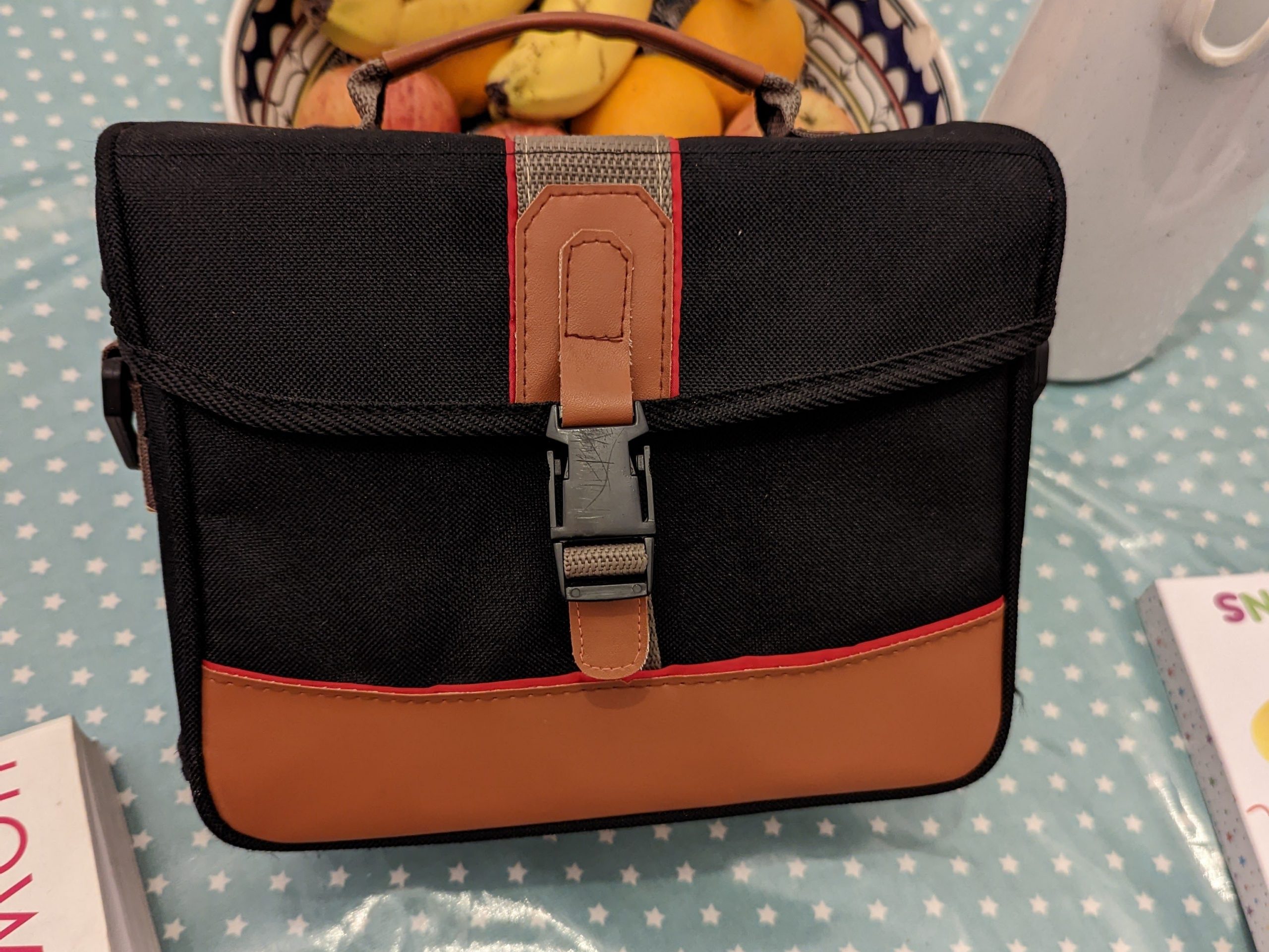
To many the best bit of these cameras are the bag. It’s a cheap affair but feels more sturdy than the camera. Plastic outer and lining with a very thin 1-2 mm of foam under the lining but it doesn’t line all the way round. There are faux leather vinyl accents and it come with a strap. The base has oddly a set of 4 little feet. I doubt it’s much more than light splash resistant
The OY4040 In Use
It’s heavy and cumbersome. the extra 100gms of weight v the Tamashi is telling. I enjoyed the Tamashi, unlike this. The Tamashi also has more sensible robust aperture control.
The waist finder is really the only boon here.
Aperture setting is not as easy to read as other color optical cameras which usually show weather indicators (+/- aperture). As mentioned you’ll probably manually set this rather than use the power zoom buttons
The winder is noisy. It will keep trying to wind when you reach the end of the roll. You need to turn the dial to the rewind setting.
My flash took about 17-20sec to power up first time out after letting it sit empty for some weeks. That drops to 8-10 sec on a re charge in consecutive shooting.
Results – Mileage May Vary
I will be clear results will vary between individual cameras of the same model due to the shoddy Q.C. If you pick one up you may get one that shoots better or worse,
Assuming I calculated expsoure correctly, the aperture seems to be in ball park. I shot 2 rolls of 100 ISO film using a Sunny 16 approach and got 38 shots back. Only 2 were duds from an exposure point of view (underexposed). But I do think I chanced those.
I would say that camera shake due to weight of the camera added to some of the softness in images. What was clear is objects 1-3m in the centre of the frame could actually be approaching sharp. But Whilst I got some sharper shots nearby I never got any long shots as good centrally indicating the lens was out a little.
This was telling on this unintentional Bokeh style shot. the flowers in foreground almost are in focus, the background ain’t and thi is fixed focus.
Except oddly the left side of the images were often sharper at long distances when the lens was more closed down go figure !

Away from centre things fall of quite a bit. There is obvious chromatic fringing but radial distortion (Pincushion) is less than you might suspect
And narrowing the aperture helps too. As the shot below shows. I suspect the would be quite poor Q.C in production and some of these will be better shooters than others.

Final Thoughts on The Olympia OY4040
The Olympia brand is in the premier league of Scameras, only beaten in scam-ness by the blatant rip-off fake Canon models. The pointless power zoom shenanigans make this a worse choice than some of the other models.
Optically this isn’t great even by Color Optical lens standards but given the shoddy build quality. But I may just have got a poor one. It isn’t helped by the fact it ways almost ¾ of a Kilo (about 1lb in old money). My Tamashi feels better built and lighter and is much better optically (but again I reckon I got a good ‘un). Nor does it have the crapness of the Power zoom feature.
So the moral is buy another color optical lens camera if you wanna dabble. The viewfinders are the only redeeming thing here (and that’s not saying much). The Flash and weirdly the powerful but shoddy flash are another plus. And if you must buy don’t pay more than a few quid
Alternatives to the OY4040
I’ve said enough about other colour optical lens cameras. But if you want something similar there are a few choices. The closest in production camera is arguably the Holga 135BC which offers 2 aperture a B mode and may or may not be focusable. If you can cope with the jump to medium format an original Diana Clone or modern Diana F+ give a similar Lo-Fi vibe but marginally more robust. The F+ is a proper system camera allowing you to shoot a range of film formats other than just 120 and change lenses but can be treated the same. With a choice of 3-4 aperture stops and focusing but plastic lensed. Of course mention that you must also consider the Holga 120 series.
Second hand, the Halina 1000 (aka Ansco 35) offers a fixed focus choice of aperture for 35. It has some retro charm too and a signature Lo-Fi look. Likewise the Agfa Isoly 100 has similar retro charms with and interesting exposure adjustment (fixed aperture changing shutter)
Other sources
The only other reviews of Olympia cameras I’ve seen are Madison Beach’s short YouTube video of the DL2000A. Bellamy at JCH reviewed a DL-9000 which is likely a rebrand of the same Olympia model. Mike Eckman also reviewed the same camera under Canon fakery

